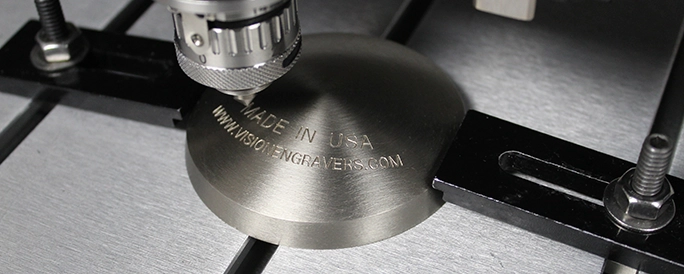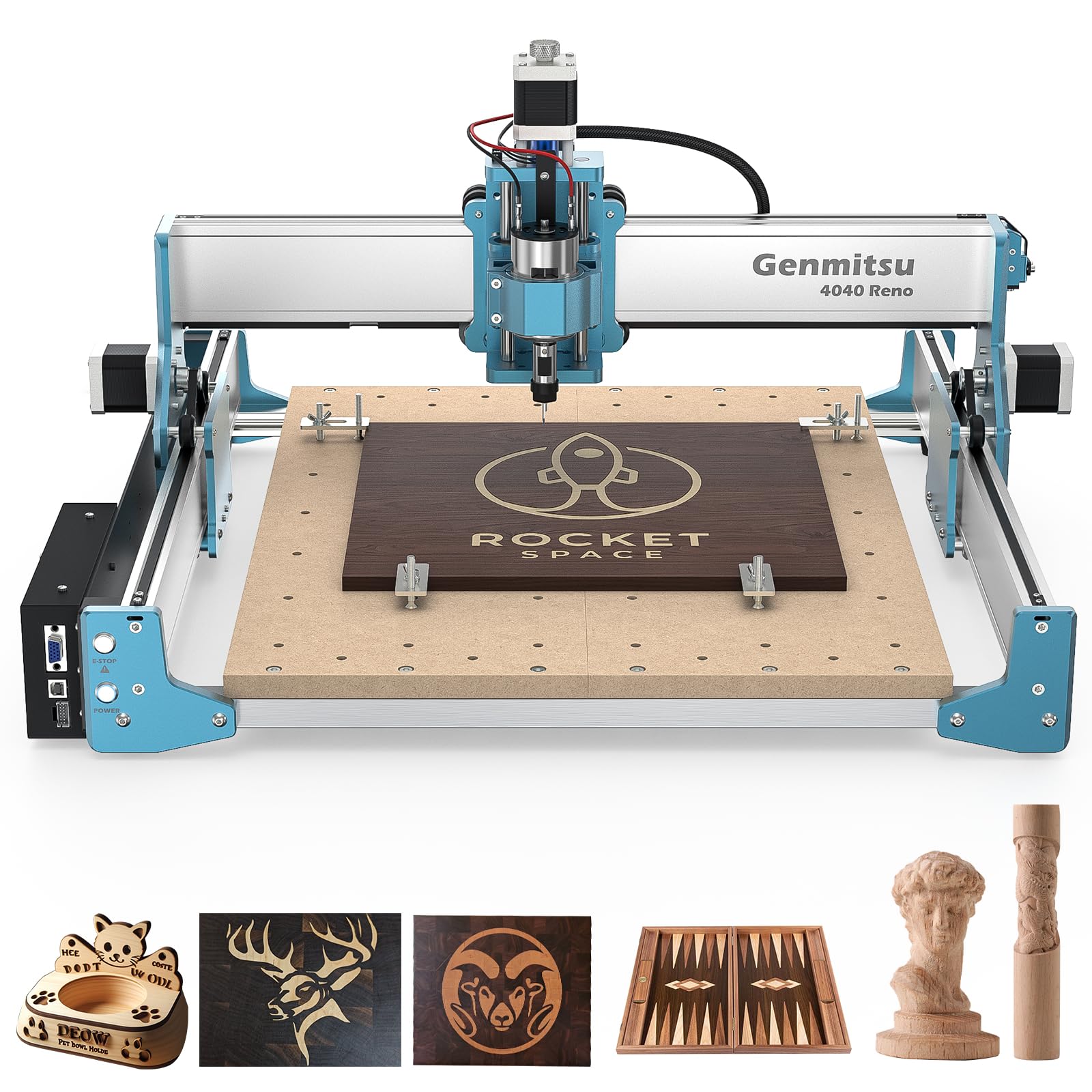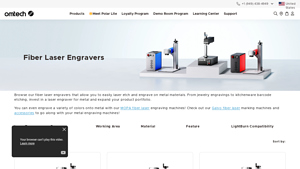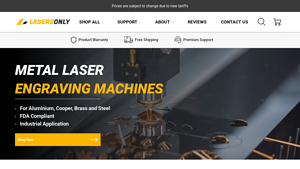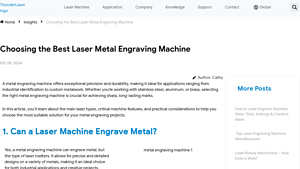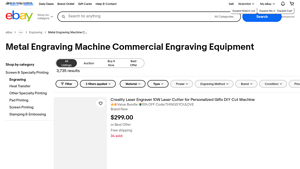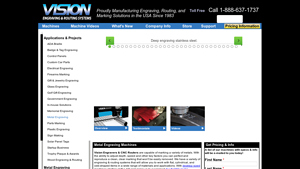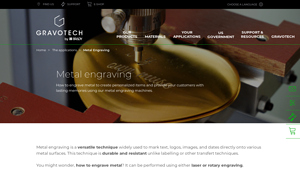Metal Carving Machine Guide: Type, Cost, Top List…
Introduction: Navigating the Global Market for metal carving machine
In the competitive landscape of metal carving machines, international buyers face the challenge of identifying reliable suppliers that meet their specific needs while ensuring quality and cost-effectiveness. Sourcing the right metal carving machine is not just about price; it involves understanding the nuances of different technologies, such as fiber laser engravers and rotary engraving systems, each suited for various applications—from industrial parts to customized jewelry. This guide aims to equip B2B buyers, particularly those from Africa, South America, the Middle East, and Europe, with comprehensive insights into the global market for metal carving machines.
Throughout this guide, we will explore various types of metal carving machines, their applications across diverse industries, and key factors to consider when selecting suppliers. We will also provide a detailed analysis of costs, helping buyers to navigate budget constraints while maximizing value. Additionally, we will discuss essential vetting processes to ensure that suppliers not only deliver quality machines but also provide ongoing support and service.
By empowering buyers with actionable insights and strategic information, this guide facilitates informed purchasing decisions, enabling businesses to enhance their operational efficiency and product offerings in the metal engraving sector. Whether you are entering the market for the first time or looking to upgrade your existing machinery, understanding the global landscape will be crucial for your success.
Understanding metal carving machine Types and Variations
| Type Name | Key Distinguishing Features | Primary B2B Applications | Brief Pros & Cons for Buyers |
|---|---|---|---|
| Fiber Laser Engraving Machine | High precision, deep engraving, and fast processing speed. | Jewelry, industrial parts, and promotional items. | Pros: High accuracy and versatility; Cons: Higher initial investment. |
| CO2 Laser Engraving Machine | Uses CO2 gas for engraving; suitable for a variety of materials. | Wood, acrylic, glass, and some metals. | Pros: Good for detailed work; Cons: Less effective on thick metals. |
| Rotary Engraving Machine | Mechanically engraves using rotating tools; ideal for cylindrical objects. | Trophies, awards, and personalized gifts. | Pros: Excellent for deep engraving; Cons: Slower than laser options. |
| MOPA Fiber Laser Engraver | Allows engraving in multiple colors on metal; more flexible power settings. | Custom metal products and artistic designs. | Pros: Color engraving capabilities; Cons: Requires more operator skill. |
| Galvo Laser Engraving Machine | Utilizes galvanometer for rapid engraving; compact design. | High-volume production runs and industrial applications. | Pros: Fast processing speeds; Cons: Limited to specific applications. |
What Are the Characteristics of Fiber Laser Engraving Machines?
Fiber laser engraving machines are known for their exceptional precision and speed, making them a popular choice for businesses needing high-quality engravings. They operate by using a fiber optic laser to etch designs into metals, such as stainless steel and aluminum. These machines are particularly suitable for applications in jewelry making, industrial part marking, and promotional item customization. When considering a purchase, B2B buyers should evaluate their production volume needs, as well as the types of materials they plan to work with, to ensure the machine meets their requirements.
How Do CO2 Laser Engraving Machines Work?
CO2 laser engraving machines use a gas mixture that includes carbon dioxide to create a powerful laser beam. This type of machine is versatile and can engrave various materials, including wood, acrylic, and glass, in addition to metals. While they are excellent for detailed designs, they may struggle with thicker metals compared to fiber lasers. B2B buyers should consider their specific material needs and the type of projects they will undertake, as well as the machine’s operational costs and maintenance requirements.
What Makes Rotary Engraving Machines Unique?
Rotary engraving machines are ideal for engraving cylindrical objects like trophies and awards. They utilize a rotating tool to achieve deep and consistent engravings, making them suitable for applications that require a polished finish. While they are slower than laser engravers, their ability to handle a variety of materials is a significant advantage. Buyers should assess their production speed requirements and whether they need the capability to engrave on non-flat surfaces.
What Are the Benefits of MOPA Fiber Laser Engravers?
MOPA fiber laser engravers stand out for their ability to create multi-colored engravings on metal surfaces. They offer adjustable power settings, which enhances their versatility for different engraving tasks. This type of machine is particularly beneficial for businesses focused on custom designs and artistic applications. B2B buyers should consider the skill level required to operate these machines effectively, as well as their potential for expanding product offerings.
Why Choose Galvo Laser Engraving Machines?
Galvo laser engraving machines employ a galvanometer system to deliver high-speed engraving, making them suitable for high-volume production environments. Their compact design allows for efficient space utilization in manufacturing settings. However, their application is often limited to specific tasks. B2B buyers should evaluate the types of projects they plan to undertake and whether the speed and efficiency of a Galvo machine align with their production goals.
Key Industrial Applications of metal carving machine
| Industry/Sector | Specific Application of metal carving machine | Value/Benefit for the Business | Key Sourcing Considerations for this Application |
|---|---|---|---|
| Manufacturing | Custom Parts Fabrication | Enhanced precision and reduced waste in production | Machine compatibility with various metal types and thicknesses |
| Jewelry and Accessories | Personalized Engraving | Increased product value and customer satisfaction | Quality of engraving detail and machine speed |
| Automotive | Component Marking and Identification | Improved traceability and compliance with regulations | Durability of engravings under harsh conditions |
| Aerospace | Part Marking and Serial Number Engraving | Ensured safety and compliance with industry standards | Precision and reliability of the engraving process |
| Signage and Branding | Custom Signage Production | Enhanced brand visibility and customer engagement | Material compatibility and design flexibility |
How Are Metal Carving Machines Used in Manufacturing?
In the manufacturing sector, metal carving machines are pivotal for custom parts fabrication. These machines are utilized to create intricate designs and precise cuts on various metal materials, significantly enhancing production efficiency. The ability to produce complex components with minimal waste leads to cost savings and improved operational efficiency. International buyers should consider machine compatibility with diverse metal types and thicknesses, ensuring it meets their production needs.
What Role Do Metal Carving Machines Play in Jewelry and Accessories?
In the jewelry and accessories industry, metal carving machines are employed for personalized engraving. This application allows businesses to add unique designs, names, or messages to products, thereby increasing their value and appeal to customers. The demand for high-quality engravings necessitates machines that can deliver exceptional detail and speed. Buyers should prioritize machines that offer versatility in design options and engraving depth to cater to different materials and customer preferences.
How Are Metal Carving Machines Essential for Automotive Applications?
For the automotive industry, metal carving machines are crucial for component marking and identification. These machines engrave serial numbers and other identifiers on parts, enhancing traceability and compliance with industry regulations. This process not only improves safety standards but also facilitates inventory management. Buyers should focus on the durability of the engravings, ensuring they can withstand harsh automotive environments without degradation.
Why Are Metal Carving Machines Important in Aerospace?
In aerospace applications, metal carving machines are vital for part marking and serial number engraving. This process ensures compliance with stringent safety regulations and traceability requirements in the aerospace sector. Precision is paramount, as any error can have significant implications for safety. Buyers must ensure that the machines they source offer high reliability and precision, as well as the capability to handle various materials used in aerospace manufacturing.
How Do Metal Carving Machines Enhance Signage and Branding?
In the signage and branding sector, metal carving machines are used to produce custom signage. These machines create high-quality, durable signs that enhance brand visibility and customer engagement. The ability to engrave intricate designs and logos on various metal substrates allows businesses to create unique branding elements. Sourcing considerations should include material compatibility and design flexibility to accommodate various signage requirements and aesthetics.
3 Common User Pain Points for ‘metal carving machine’ & Their Solutions
Scenario 1: Difficulty in Achieving Precision in Complex Designs
The Problem: Many B2B buyers in the metal carving industry face challenges when attempting to produce intricate designs with high precision. This is particularly relevant for industries such as jewelry manufacturing or custom metal signage, where fine details are crucial. A lack of precision can lead to wasted materials, increased production time, and ultimately, dissatisfied customers. Buyers often struggle to find machines that can consistently deliver the level of detail they require without sacrificing speed or efficiency.
The Solution: To address this pain point, buyers should prioritize investing in fiber laser engraving machines known for their high precision and capability to work with detailed designs. Look for machines equipped with advanced optics and high-resolution capabilities (1,000 DPI or higher). Additionally, implementing software solutions like LightBurn can enhance design precision by allowing for detailed vector graphics processing. Buyers should also consider the machine’s working area; a larger workspace can provide flexibility for various project sizes. Regular maintenance and calibration of the machine are crucial to ensure consistent performance, reducing the risk of errors during production.
Scenario 2: High Operating Costs and Maintenance Issues
The Problem: Operating costs associated with metal carving machines can be a significant concern for B2B buyers, especially in regions with fluctuating energy prices or limited access to affordable maintenance services. Additionally, frequent breakdowns and the need for specialized repairs can lead to costly downtime, impacting overall productivity and profitability. Buyers often feel pressured to choose between investing in lower-cost machines that may not deliver on quality or higher-end models with high maintenance needs.
The Solution: To mitigate these issues, buyers should conduct a thorough cost-benefit analysis before purchasing. Investing in high-quality, energy-efficient machines can reduce long-term operating costs. Machines with robust warranties and readily available parts can minimize downtime and maintenance expenses. Buyers should also seek out suppliers that offer comprehensive support, including training for operators to reduce the likelihood of user error, which can lead to mechanical issues. Establishing a regular maintenance schedule can proactively address potential problems, ensuring that the machine operates efficiently over its lifespan.
Scenario 3: Challenges with Material Compatibility
The Problem: B2B buyers often encounter compatibility issues when using metal carving machines with various materials. Whether they are working with stainless steel, aluminum, or brass, understanding which machines can handle specific materials effectively is crucial. Incompatible machines can lead to poor engraving quality or even damage to the materials, resulting in wasted resources and potential delays in project timelines.
The Solution: Buyers should prioritize machines that are versatile and explicitly designed to handle multiple types of metals. When evaluating options, consider the machine’s specifications, including the type of laser technology (fiber vs. CO2) and its power settings, which can significantly affect performance on different materials. It’s also beneficial to engage with suppliers who provide sample tests on various materials, allowing buyers to see firsthand how well the machine performs before making a commitment. Additionally, consider the availability of accessories or attachments that can enhance the machine’s capabilities for specific materials, such as rotary attachments for cylindrical objects. This strategic approach can help ensure that the investment meets diverse project needs while maintaining quality standards.
Strategic Material Selection Guide for metal carving machine
What Are the Key Properties of Common Materials Used in Metal Carving Machines?
When selecting materials for metal carving machines, understanding the properties and applications of various metals is crucial for B2B buyers. Here, we analyze four commonly used materials: Aluminum, Stainless Steel, Brass, and Copper. Each material has unique properties that influence its performance in metal carving applications.
How Does Aluminum Perform in Metal Carving Applications?
Aluminum is lightweight, corrosion-resistant, and has excellent thermal conductivity. It can withstand moderate temperatures and pressures, making it suitable for various engraving tasks. Its lower density compared to other metals allows for faster processing speeds, which can enhance productivity.
Pros: Aluminum is relatively inexpensive and easy to machine, making it a popular choice for both small and large-scale operations. Its lightweight nature allows for easier handling and transport.
Cons: While durable, aluminum can be softer and more prone to scratching compared to harder metals. This can affect the longevity of the engraved designs, especially in high-wear applications.
Impact on Application: Aluminum is commonly used for promotional items, signage, and decorative pieces. It is compatible with various engraving techniques, including laser and rotary engraving.
Considerations for International Buyers: Buyers from regions like Europe and the Middle East should ensure compliance with relevant standards such as DIN and ASTM for material quality. Additionally, the availability of aluminum may vary, affecting lead times.
What Are the Benefits of Using Stainless Steel in Metal Carving?
Stainless steel is renowned for its strength, durability, and corrosion resistance. It can withstand high temperatures and pressures, making it ideal for industrial applications. Its aesthetic appeal also makes it popular for decorative items.
Pros: Stainless steel is highly durable, making it suitable for products that require longevity and resistance to wear and tear. It also offers a high-end finish that is appealing for consumer products.
Cons: The higher cost and increased difficulty in machining can be a drawback for some manufacturers. Specialized tools and techniques may be required, increasing production complexity.
Impact on Application: Stainless steel is often used for industrial parts, kitchenware, and high-end consumer products. Its compatibility with various engraving methods allows for intricate designs and markings.
Considerations for International Buyers: Compliance with international standards such as ISO and ASTM is essential, especially in regulated industries. Buyers should also consider the availability of stainless steel and its associated costs in their region.
Why Choose Brass for Metal Carving Projects?
Brass is an alloy of copper and zinc, known for its excellent machinability and corrosion resistance. It has good thermal and electrical conductivity, making it suitable for various applications.
Pros: Brass is easy to engrave and produces high-quality finishes, making it ideal for decorative items and precision components. Its aesthetic appeal is also a significant advantage.
Cons: Brass can be more expensive than aluminum and may require more careful handling to avoid tarnishing. Additionally, it is not as strong as stainless steel, which may limit its applications.
Impact on Application: Brass is commonly used in jewelry, musical instruments, and decorative hardware. Its compatibility with laser engraving allows for detailed designs.
Considerations for International Buyers: Buyers should be aware of the specific grades of brass available in their region and ensure compliance with relevant standards. The availability of high-quality brass can vary significantly by region.
What Advantages Does Copper Offer in Metal Carving?
Copper is highly conductive and malleable, making it easy to work with and engrave. It has excellent corrosion resistance and can withstand high temperatures.
Pros: Copper’s excellent conductivity makes it ideal for electrical components and applications requiring heat dissipation. It also provides a unique aesthetic appeal for decorative items.
Cons: Copper can be more expensive than aluminum and brass and is softer, which may lead to wear over time. Its tendency to tarnish can also affect the appearance of engraved items.
Impact on Application: Copper is often used in electrical applications, art pieces, and decorative items. Its compatibility with various engraving techniques allows for detailed work.
Considerations for International Buyers: Compliance with international standards is crucial for electrical applications. Buyers should also consider the cost implications of sourcing copper in their regions.
Summary Table of Material Selection for Metal Carving Machines
| Material | Typical Use Case for metal carving machine | Key Advantage | Key Disadvantage/Limitation | Relative Cost (Low/Med/High) |
|---|---|---|---|---|
| Aluminum | Promotional items, signage | Lightweight and cost-effective | Softer, prone to scratching | Low |
| Stainless Steel | Industrial parts, kitchenware | High durability and aesthetic appeal | Higher cost and machining complexity | High |
| Brass | Jewelry, musical instruments | Excellent finish and machinability | More expensive, tarnishing issues | Medium |
| Copper | Electrical components, decorative items | High conductivity and unique appeal | Softness and tarnishing | Medium |
This strategic material selection guide provides B2B buyers with insights into the properties and applications of common materials used in metal carving machines, helping them make informed purchasing decisions.
In-depth Look: Manufacturing Processes and Quality Assurance for metal carving machine
What Are the Key Stages in the Manufacturing Process of Metal Carving Machines?
Manufacturing a metal carving machine involves several crucial stages, each designed to ensure efficiency and precision. The main stages include material preparation, forming, assembly, and finishing.
-
Material Preparation: The process begins with selecting high-quality materials, typically metals like stainless steel or aluminum, which are known for their durability and corrosion resistance. Suppliers must ensure that the raw materials meet industry standards. This often involves testing for tensile strength and hardness before proceeding.
-
Forming: Once the materials are prepared, they undergo forming processes such as laser cutting or CNC machining. These techniques allow for precise shaping and cutting of components, ensuring that parts fit together seamlessly. Advanced technologies like fiber lasers are often employed for their ability to create intricate designs with minimal thermal distortion.
-
Assembly: After forming, the next stage is assembly, where the various components of the machine are brought together. This can include the integration of electronics, motors, and software systems. Skilled technicians typically oversee this process to ensure that all parts are aligned correctly and functioning as intended.
-
Finishing: The final stage involves surface finishing, which may include polishing, coating, or painting. These processes not only enhance the aesthetic appeal of the machine but also protect it from environmental factors. Quality finishing is vital, as it affects the machine’s performance and longevity.
How Is Quality Assurance Implemented in Metal Carving Machine Manufacturing?
Quality assurance (QA) is critical in ensuring that metal carving machines meet both international standards and customer expectations. The following outlines the key aspects of QA in this industry.
-
International Standards: Many manufacturers adhere to ISO 9001, which focuses on quality management systems. Compliance with this standard demonstrates a commitment to quality and continuous improvement. Additionally, certifications like CE (Conformité Européenne) and API (American Petroleum Institute) may be relevant depending on the machine’s intended application.
-
Quality Control Checkpoints: Implementing a robust quality control system involves several checkpoints:
– Incoming Quality Control (IQC): This step involves inspecting raw materials upon arrival to ensure they meet specified standards.
– In-Process Quality Control (IPQC): During manufacturing, quality checks are performed at various stages to identify defects early. This can include dimensional checks and functional tests.
– Final Quality Control (FQC): Once assembly is complete, the final product undergoes comprehensive testing to ensure it operates correctly and meets all specifications. -
Common Testing Methods: Various testing methods are employed to verify the machine’s performance and reliability. These can include:
– Functional testing to ensure all components operate as intended.
– Endurance testing to assess how the machine performs under prolonged use.
– Safety testing to ensure compliance with safety standards.
How Can B2B Buyers Verify Supplier Quality Control Processes?
For international B2B buyers, verifying a supplier’s quality control processes is essential to ensuring the reliability of their products. Here are several strategies to achieve this:
-
Supplier Audits: Conducting supplier audits can provide insights into the manufacturing processes and quality assurance measures in place. Buyers should look for documented procedures, employee training programs, and adherence to international standards.
-
Quality Reports: Requesting quality reports can help buyers assess the effectiveness of a supplier’s quality control system. These reports should detail inspection results, defect rates, and corrective actions taken.
-
Third-Party Inspections: Engaging a third-party inspection service can add an additional layer of assurance. These services can conduct independent evaluations of the manufacturing process and final products to ensure compliance with specified standards.
What Are the Quality Control Nuances for International B2B Buyers?
Navigating quality control nuances is particularly important for B2B buyers from diverse regions such as Africa, South America, the Middle East, and Europe. Here are some factors to consider:
-
Cultural Differences: Understanding cultural differences in business practices can affect quality expectations. For instance, European buyers may have stricter compliance requirements compared to other regions. It’s essential for manufacturers to be aware of these differences and adapt their quality assurance processes accordingly.
-
Regulatory Compliance: Different regions have varying regulatory standards. Buyers must ensure that their suppliers comply with local regulations in their target markets. This may involve additional certifications or documentation.
-
Language Barriers: Language differences can lead to misunderstandings in quality specifications. Clear communication is vital, so providing documentation in multiple languages can enhance clarity and reduce the risk of errors.
-
Logistical Considerations: The logistics of transporting heavy machinery can pose challenges. Ensuring that quality is maintained throughout the shipping process is essential. Buyers should inquire about the supplier’s packaging and handling practices to prevent damage during transit.
Conclusion
Understanding the manufacturing processes and quality assurance measures for metal carving machines is crucial for B2B buyers. By familiarizing themselves with the stages of manufacturing, quality control standards, and verification methods, buyers can make informed decisions when selecting suppliers. Additionally, being aware of international nuances in quality assurance will help buyers navigate the complexities of global trade effectively. This comprehensive approach ensures that they acquire reliable machines that meet their operational needs and quality standards.
Practical Sourcing Guide: A Step-by-Step Checklist for ‘metal carving machine’
Introduction
Sourcing a metal carving machine is a critical investment for businesses looking to enhance their manufacturing capabilities. This guide provides a practical checklist to ensure that B2B buyers make informed decisions, considering technical specifications, supplier reliability, and total cost of ownership.
Step 1: Define Your Technical Specifications
Begin by outlining the specific requirements for your metal carving machine. Consider factors such as the types of materials you will be engraving, the desired engraving depth, and the intricacy of designs.
- Material Compatibility: Ensure the machine can handle various metals like stainless steel, aluminum, or brass.
- Power and Speed: Evaluate the wattage and engraving speed necessary for your production needs.
Step 2: Research Different Types of Machines
Familiarize yourself with the various technologies available, such as fiber lasers, CO2 lasers, and rotary engraving machines. Each type offers unique benefits depending on your applications.
- Fiber Lasers: Best for high-speed engraving on metals with precision.
- CO2 Lasers: Suitable for both metal and non-metal materials, offering versatility.
Step 3: Evaluate Potential Suppliers
Before committing, it’s crucial to vet suppliers thoroughly. Request company profiles, case studies, and references from buyers in a similar industry or region.
- Supplier Track Record: Look for suppliers with a proven history of delivering high-quality machines.
- Customer Reviews: Check online platforms for testimonials and user experiences.
Step 4: Verify Compliance and Certifications
Confirm that the suppliers’ machines comply with international standards and certifications relevant to your region. This step is vital to ensure safety and performance.
- ISO Certifications: Look for ISO 9001 for quality management and ISO 14001 for environmental management.
- Local Regulations: Ensure compliance with local safety and operational regulations.
Step 5: Request Demonstrations and Samples
Whenever possible, request a demonstration of the machine or samples of its work. This allows you to assess the machine’s performance and the quality of the output firsthand.
- Test Runs: Inquire if the supplier can perform test runs with your specific materials.
- Quality Assurance: Evaluate the consistency and precision of the engraving.
Step 6: Consider Total Cost of Ownership
Understand the total cost involved, including initial purchase price, maintenance, consumables, and potential downtime. This will help you assess the long-term value of the investment.
- Maintenance Costs: Investigate routine maintenance requirements and associated costs.
- Warranty and Support: Check the warranty period and the level of after-sales support provided.
Step 7: Negotiate Terms and Conditions
Finally, engage in negotiations to secure favorable terms. This includes payment terms, delivery schedules, and installation support.
- Payment Flexibility: Explore options for leasing or financing if upfront costs are a concern.
- Installation and Training: Ensure the supplier offers installation services and operator training to maximize your machine’s capabilities.
By following this checklist, B2B buyers can confidently navigate the procurement process for a metal carving machine, ensuring they make an investment that meets their operational needs and business goals.
Comprehensive Cost and Pricing Analysis for metal carving machine Sourcing
What Are the Key Cost Components in Sourcing Metal Carving Machines?
When sourcing metal carving machines, understanding the cost structure is crucial for B2B buyers. The primary cost components include:
-
Materials: The type of materials used in manufacturing the machine significantly impacts the overall cost. For instance, high-quality metals and durable components increase the price but also the longevity and efficiency of the machine.
-
Labor: Labor costs can vary widely depending on the geographical location of the manufacturer. Regions with higher wage standards may lead to increased costs, while countries with lower labor costs can provide competitive pricing.
-
Manufacturing Overhead: This includes costs associated with factory operations, utilities, and equipment maintenance. Efficient production processes can help minimize overhead, impacting the final price.
-
Tooling: Custom tooling for specific designs can add to the initial investment. Buyers should consider whether standard tooling suffices or if specialized tooling is required for their projects.
-
Quality Control (QC): Rigorous QC processes ensure product reliability and performance, but they can also elevate costs. Invest in suppliers who prioritize QC to mitigate long-term risks associated with machine failure.
-
Logistics: Shipping costs can vary based on the machine’s size and weight, destination, and shipping method. International buyers should account for potential customs duties and taxes that can further affect the total cost.
-
Margin: Supplier margins influence pricing. Understanding the supplier’s market position and pricing strategy can help buyers negotiate better terms.
How Do Price Influencers Affect Metal Carving Machine Sourcing?
Several factors influence the pricing of metal carving machines, including:
-
Volume and Minimum Order Quantity (MOQ): Larger orders often qualify for bulk pricing discounts, while smaller orders may not. Buyers should evaluate their needs to optimize costs.
-
Specifications and Customization: Custom features, such as advanced laser types or specific software compatibility, can significantly increase the cost. Buyers should weigh the benefits of customization against the added expense.
-
Materials and Quality Certifications: Machines made from higher-grade materials or those that meet specific international quality standards (ISO, CE, etc.) typically command higher prices. Certifications can also influence resale value.
-
Supplier Factors: The reputation and reliability of suppliers play a crucial role in pricing. Established suppliers may charge more but often provide better support and warranty options.
-
Incoterms: Understanding shipping terms (e.g., FOB, CIF) is vital for calculating total costs. Incoterms affect the responsibility for shipping, insurance, and tariffs, impacting the buyer’s overall expenditure.
What Buyer Tips Can Help Negotiate Better Prices for Metal Carving Machines?
For B2B buyers, especially those in regions like Africa, South America, the Middle East, and Europe, employing strategic sourcing techniques can enhance cost efficiency:
-
Negotiation: Always negotiate terms with suppliers. Request volume discounts, payment terms, or bundled services to lower overall costs. Building a relationship can often yield better pricing in the long run.
-
Total Cost of Ownership (TCO): Evaluate the TCO, which includes acquisition, operation, maintenance, and disposal costs. A lower upfront price may not be the most economical choice if the machine incurs high operational costs.
-
Pricing Nuances for International Buyers: International buyers should be aware of currency fluctuations and their potential impact on pricing. Consider locking in exchange rates or opting for suppliers who offer pricing in your local currency.
-
Research and Compare: Conduct thorough market research to compare prices and features across different suppliers. Utilize platforms that specialize in B2B transactions to gain insights into prevailing market rates.
Conclusion
Understanding the comprehensive cost and pricing analysis for metal carving machines is essential for making informed purchasing decisions. By considering the various cost components, recognizing price influencers, and utilizing effective buyer strategies, international B2B buyers can navigate the sourcing landscape more effectively. Always remember that indicative prices may vary based on market conditions and specific requirements, making ongoing research and flexibility key to successful sourcing.
Alternatives Analysis: Comparing metal carving machine With Other Solutions
Introduction to Alternative Solutions for Metal Carving
In the realm of metalworking, particularly for engraving and carving, businesses often seek the most efficient and cost-effective solutions. While metal carving machines have become popular for their precision and versatility, other technologies and methods can achieve similar results. This section explores viable alternatives, helping B2B buyers make informed decisions based on their specific needs and operational contexts.
Comparison Table of Metal Carving Machine and Alternatives
| Comparison Aspect | Metal Carving Machine | Fiber Laser Engraver | Rotary Engraving Machine |
|---|---|---|---|
| Performance | High precision and detail | Excellent for intricate designs; fast processing | Good for deep engraving on various materials |
| Cost | Moderate to high investment | Varies ($2,200 – $12,000) | Generally lower ($1,000 – $5,000) |
| Ease of Implementation | Requires skilled operators | User-friendly with software support | Simple setup, minimal training needed |
| Maintenance | Moderate; needs calibration | Low; generally robust | Moderate; tool replacement needed |
| Best Use Case | Complex designs, custom pieces | Industrial parts, jewelry, promotional items | Awards, signage, and name tags |
Detailed Breakdown of Alternatives
Fiber Laser Engraver
Fiber laser engravers represent a powerful alternative to traditional metal carving machines. They excel in creating intricate designs with high speed and precision, making them ideal for applications such as jewelry engraving and industrial parts marking. The initial cost can be significant, ranging from $2,200 to $12,000, depending on the model and capabilities. However, the low maintenance requirements and user-friendly software make them a compelling option for businesses looking to enhance their engraving capabilities. The main drawback is the need for skilled operators to maximize the machine’s potential.
Rotary Engraving Machine
Rotary engraving machines are another viable option, particularly for businesses focused on producing awards, signage, and name tags. These machines are typically more affordable, with prices ranging from $1,000 to $5,000, making them accessible for smaller businesses or startups. They are relatively easy to implement and require minimal training for operators. However, while rotary machines can produce deep engravings, they may lack the intricate detail and speed offered by fiber laser engravers. This makes them less suitable for complex designs but effective for straightforward tasks.
Conclusion: How to Choose the Right Metal Carving Solution
Selecting the right engraving solution depends on various factors, including budget, desired precision, and the specific applications of your products. For businesses that prioritize intricate designs and high-speed production, investing in a fiber laser engraver may yield the best long-term returns. Conversely, if the focus is on cost-effectiveness and simpler applications like awards or signage, a rotary engraving machine could be the most suitable choice. By carefully evaluating these alternatives, B2B buyers can find the ideal solution that aligns with their operational goals and market demands.
Essential Technical Properties and Trade Terminology for metal carving machine
What Are the Key Technical Properties of Metal Carving Machines?
When considering the acquisition of a metal carving machine, it is essential to understand several critical technical properties that directly influence performance and suitability for specific applications. Here are the key specifications to evaluate:
-
Laser Power (Wattage)
– The laser power is measured in watts (W) and indicates the machine’s capability to engrave or cut through materials. Higher wattage allows for faster processing speeds and the ability to work with thicker materials. For B2B buyers, selecting a machine with appropriate wattage ensures efficiency and versatility in production. -
Working Area
– This refers to the maximum dimensions of the material that can be processed in a single operation. A larger working area enables the handling of bigger parts or multiple smaller components simultaneously, increasing productivity. Understanding the working area is crucial for businesses that require high-volume production or large-scale projects. -
Material Compatibility
– Different machines are designed to work with various materials, including stainless steel, aluminum, brass, and more. Assessing material compatibility is vital for companies that need to engrave or cut specific materials as it affects the machine’s performance and output quality. -
Precision and Tolerance
– Precision refers to the machine’s ability to maintain accuracy during operation, while tolerance indicates the allowable deviation from specified dimensions. High precision and low tolerance are critical for applications requiring intricate designs and components. Businesses must prioritize these factors to ensure product quality and minimize waste. -
Cooling System
– The cooling system is essential for maintaining optimal operating temperatures during prolonged use. Efficient cooling prevents overheating, which can lead to equipment damage and reduced longevity. Understanding the type and efficiency of the cooling system helps buyers choose machines that ensure reliability and durability. -
Software Compatibility
– Many modern metal carving machines come with proprietary software or compatibility with popular design software. This feature is crucial for seamless integration into existing workflows, allowing for easy design modifications and efficient operation. Evaluating software compatibility can enhance the overall productivity of a business.
What Are Common Trade Terms Related to Metal Carving Machines?
Understanding industry jargon is equally important for effective communication and negotiation in the procurement process. Here are several key terms:
-
OEM (Original Equipment Manufacturer)
– This refers to a company that produces parts or equipment that may be marketed by another manufacturer. In the context of metal carving machines, OEMs often provide custom solutions and parts, making it essential for buyers to know their suppliers. -
MOQ (Minimum Order Quantity)
– MOQ is the smallest quantity of a product that a supplier is willing to sell. Understanding MOQ is vital for B2B buyers to manage inventory effectively and ensure they meet supplier requirements without overcommitting resources. -
RFQ (Request for Quotation)
– An RFQ is a formal document soliciting a quote from suppliers for specific products or services. Buyers use RFQs to compare prices and terms from multiple vendors, aiding in the decision-making process. -
Incoterms (International Commercial Terms)
– These are standardized trade terms that define the responsibilities of buyers and sellers in international transactions. Familiarity with Incoterms helps buyers understand shipping costs, risk transfer, and delivery obligations, which are crucial for planning and budgeting. -
Lead Time
– Lead time refers to the duration from placing an order to receiving the product. Knowing the lead time is essential for production planning and ensuring that projects stay on schedule. -
Service Level Agreement (SLA)
– An SLA is a contract between a service provider and a customer that outlines the expected service standards. For metal carving machine buyers, SLAs can detail maintenance, support response times, and performance metrics, ensuring that their investment is protected and operational downtime is minimized.
By understanding these technical properties and trade terms, B2B buyers can make informed decisions when selecting metal carving machines that meet their operational needs and enhance their production capabilities.
Navigating Market Dynamics and Sourcing Trends in the metal carving machine Sector
What Are the Key Trends in the Metal Carving Machine Market?
The global metal carving machine market is experiencing significant growth driven by technological advancements and increasing demand across various industries. Key trends include the rising adoption of fiber laser technology, which offers high precision and efficiency for metal engraving and cutting. As businesses seek to enhance productivity, manufacturers are focusing on developing machines that integrate smart technology, such as IoT capabilities and advanced software solutions, enabling real-time monitoring and improved operational efficiency.
International B2B buyers, particularly from Africa, South America, the Middle East, and Europe, are increasingly interested in versatile machines that can handle multiple materials and applications. For instance, machines that can engrave on metals like stainless steel, aluminum, and brass are in high demand due to their applicability in diverse sectors, including manufacturing, jewelry, and signage. Additionally, the trend towards customization is pushing companies to invest in machines that can produce intricate designs and personalized products.
Emerging markets are becoming critical players in the metal carving machine sector, driven by growing industrialization and urbanization. As these regions expand their manufacturing capabilities, international buyers are presented with opportunities to source advanced technology at competitive prices, making it essential to stay informed about local suppliers and market conditions.
How Is Sustainability Impacting Sourcing in the Metal Carving Machine Industry?
Sustainability is increasingly becoming a focal point in the metal carving machine sector, influencing sourcing decisions for B2B buyers. Companies are recognizing the environmental impact of their operations and are seeking to adopt practices that minimize waste and reduce carbon footprints. The use of energy-efficient machines and sustainable materials is a priority for many organizations, particularly in regions where environmental regulations are stringent.
Ethical sourcing is also crucial as buyers aim to partner with suppliers who demonstrate a commitment to sustainable practices. This includes ensuring that materials used in manufacturing machines are sourced responsibly and that suppliers adhere to fair labor practices. Certifications like ISO 14001 for environmental management and adherence to ethical sourcing standards are becoming essential criteria for international buyers.
Investing in machines that are designed for longevity and can be easily upgraded or repaired contributes to a circular economy, further enhancing the sustainability narrative. As businesses continue to prioritize sustainability, the demand for eco-friendly metal carving machines is expected to rise, providing a competitive advantage for suppliers who can meet these needs.
What Is the Evolution of Metal Carving Machines in the B2B Context?
The evolution of metal carving machines has been marked by significant technological advancements and shifts in market demand. Initially, traditional engraving methods relied on manual tools and mechanical devices, which limited precision and efficiency. However, the advent of laser technology revolutionized the industry, allowing for intricate designs and faster production times.
Over the years, the introduction of fiber laser engravers has further enhanced capabilities, offering greater speed, lower operational costs, and the ability to work on a wider range of materials. This evolution has been driven by the need for customization and personalization, particularly in industries such as jewelry and manufacturing.
As the market continues to mature, the focus has shifted towards integrating smart technology and automation, making machines more user-friendly and efficient. This trajectory not only improves productivity but also aligns with the growing emphasis on sustainability and ethical sourcing, shaping the future of metal carving machines in the B2B landscape.
Frequently Asked Questions (FAQs) for B2B Buyers of metal carving machine
-
How do I choose the right metal carving machine for my business needs?
Selecting the right metal carving machine involves assessing your specific requirements, such as the types of materials you’ll be working with, the desired engraving depth, and the precision needed for your projects. Consider the machine’s power, working area, and the technology it uses (fiber laser, CO2 laser, or rotary engraving). Research various brands and models, read customer reviews, and consult with suppliers to identify a machine that balances performance with your budget. Additionally, ensure that the machine can accommodate your future production needs as your business grows. -
What is the best technology for engraving metals?
Fiber laser technology is often considered the best for metal engraving due to its high precision, speed, and ability to produce deep, permanent engravings on various metal types, including stainless steel and aluminum. Fiber lasers can achieve intricate designs with high contrast and minimal material distortion. For applications requiring color engraving, MOPA (Master Oscillator Power Amplifier) technology allows for different engraving depths and colors. Assess your specific needs, such as production volume and engraving detail, to determine the most suitable technology for your projects. -
What should I consider when vetting suppliers for metal carving machines?
When vetting suppliers, evaluate their reputation, experience, and customer service. Look for reviews, testimonials, and case studies from other businesses. Ensure they offer comprehensive after-sales support, including installation, training, and maintenance services. Verify their compliance with international quality standards and certifications. Additionally, inquire about their warranty policies and the availability of spare parts. Building a relationship with a reliable supplier can significantly impact your operational efficiency and machine performance. -
What are the typical minimum order quantities (MOQs) for metal carving machines?
Minimum order quantities for metal carving machines can vary widely based on the supplier and the type of machine. Generally, established suppliers may require a minimum order of one machine, while others might have higher MOQs for bulk purchases. It is essential to clarify this during negotiations and consider your budget and operational needs. Some suppliers may offer financing options or leasing arrangements, which can help lower the initial investment if you’re not ready to commit to a large purchase. -
What payment terms should I expect when purchasing a metal carving machine?
Payment terms can vary by supplier and may include options such as full payment upfront, partial payment with the balance upon delivery, or financing arrangements. It is crucial to clarify the payment schedule, accepted payment methods (bank transfer, credit card, etc.), and any potential discounts for early payments. Understanding the terms can help you manage your cash flow effectively and ensure a smooth transaction process. Always request a detailed invoice outlining the costs associated with the purchase. -
How can I ensure quality assurance for my metal carving machine?
To ensure quality assurance, request detailed specifications and certifications from the supplier, including ISO certifications and compliance with safety standards. It is advisable to ask for sample engravings to evaluate the machine’s performance before making a purchase. Additionally, inquire about the supplier’s quality control processes and warranty policies. Establishing a clear communication channel for reporting issues or concerns post-purchase will also help maintain quality and performance. -
What logistics considerations should I keep in mind when importing a metal carving machine?
When importing a metal carving machine, consider shipping costs, customs duties, and import regulations specific to your country. Work with suppliers who have experience in international shipping to ensure proper packaging and documentation. Additionally, confirm the estimated delivery time and whether the supplier offers freight forwarding services. It is also wise to have a contingency plan for delays or damages during shipping. Collaborating with a reliable logistics partner can streamline the process and mitigate potential risks. -
Are there customization options available for metal carving machines?
Many suppliers offer customization options for metal carving machines to better suit your specific needs. Customization can include modifications to the machine’s size, power, software compatibility, or additional features such as rotary attachments for engraving cylindrical objects. Discuss your requirements with the supplier to determine what options are available and if there are additional costs associated with these customizations. Ensuring that the machine meets your unique operational requirements can enhance productivity and efficiency in your engraving projects.
Important Disclaimer & Terms of Use
⚠️ Important Disclaimer
The information provided in this guide, including content regarding manufacturers, technical specifications, and market analysis, is for informational and educational purposes only. It does not constitute professional procurement advice, financial advice, or legal advice.
While we have made every effort to ensure the accuracy and timeliness of the information, we are not responsible for any errors, omissions, or outdated information. Market conditions, company details, and technical standards are subject to change.
B2B buyers must conduct their own independent and thorough due diligence before making any purchasing decisions. This includes contacting suppliers directly, verifying certifications, requesting samples, and seeking professional consultation. The risk of relying on any information in this guide is borne solely by the reader.
Top 6 Metal Carving Machine Manufacturers & Suppliers List
1. OMTech – OMTech MOPA 100W Split Fiber Laser Engraving Machine
Domain: omtechlaser.com
Registered: 2020 (5 years)
Introduction: Fiber Laser Machines | Laser Engravers – OMTech Laser
– Product Types: Fiber Laser Engravers, Fiber Laser Cutters, Laser Welders, Pre-owned Machines, Accessories, Materials, Software
– Key Products:
– OMTech MOPA 100W Split Fiber Laser Engraving Machine
– Working Area: 6.9″ x 6.9″
– Price: $8,299.99 (Regular Price: $11,999.99, Sale Price Save: $3,700)
– Features: Easy financing options,…
2. LasersOnly – 60W Fiber Laser Marking Machine JPT MOPA M7
Domain: lasersonly.com
Registered: 2020 (5 years)
Introduction: Laser Engraving Machines for Metal, suitable for Aluminium, Copper, Brass, and Steel. FDA Compliant. Key products include: 60W Fiber Laser Marking Machine JPT MOPA M7 2 Lenses – $5,799.00, 50W Fiber Laser Marking Machine JPT MOPA LP-E – $5,149.00, 100W Fiber Laser Machine JPT MOPA M7 – $7,899.00, 30W Fiber Laser Marking Machine JPT MOPA LP-E – $4,099.00, 200W Fiber Laser Marking Machine JPT MOPA M…
3. Thunder Laser – Precision Metal Engraving Machines
Domain: thunderlaser.com
Registered: 2010 (15 years)
Introduction: A metal engraving machine offers precision and durability for applications like industrial identification and custom metalwork. Key laser types include: 1. Diode Laser: Affordable, suitable for coated surfaces, but insufficient for most metal engraving. 2. CO2 Laser: Versatile for various materials, effective on coated metals but less so on bare metals. 3. UV Laser: High precision for fine details…
4. OMTech – FM6969-30 Laser Marking Engraving Machine
Domain: ebay.com
Registered: 1995 (30 years)
Introduction: Metal Engraving Machine Commercial Engraving Equipment for sale on eBay. Popular models include OMTech FM6969-30 30W Laser Marking Engraving Machine with a 6.9″ x 6.9″ working area priced at $2,599.99, OMTech FM1212-50 Engraving Machine for $2,999.99, and CREALITY FALCON2 12W Laser Engraver/Cutter Machine priced at $4,139.00. Other options include ATOMSTACK A5 Pro 40W Laser Engraver for $9.14 and …
5. Vision Engravers – Metal Engraving Machines
Domain: visionengravers.com
Registered: 1999 (26 years)
Introduction: Metal Engraving Machines by Vision Engravers & CNC Routers are designed for marking various metals including iron, steel, brass, aluminum, gold, copper, and silver. They offer adjustable depth and speed for precise and durable markings. Available machine sizes include: Small (up to 8″ x 10″), Medium (up to 16″ x 24″), and Large (up to 24″ x 48″). Specialty engravers include models such as the NEW …
6. Gravotech – LS100 & LS100EX Laser Tables
Domain: gravotech.us
Registered: 2007 (18 years)
Introduction: Laser Tables: LS100 (Marking area: 460 x 305 mm, Materials: Plastics, wood, glass, painted surfaces, Applications: Personalization, creative, signage); LS100EX (Marking area: 610 x 305 mm, Materials: Plastics, wood, glass, painted surfaces, metals, Applications: Personalization, signage, creative); LS900 (Marking area: 610 x 610 mm, Materials: Plastics, wood, glass, painted surfaces, metals, Appli…
Strategic Sourcing Conclusion and Outlook for metal carving machine
As international markets continue to evolve, the strategic sourcing of metal carving machines becomes increasingly essential for businesses aiming to enhance their production capabilities. Key takeaways emphasize the importance of investing in advanced technology, such as fiber laser engravers, which not only improve precision but also expand product offerings—from custom jewelry to industrial components. Moreover, understanding regional market needs and technological compatibility will ensure that investments yield maximum returns.
Sourcing high-quality machinery from reputable suppliers is vital for maintaining competitive advantage, particularly in regions like Africa, South America, the Middle East, and Europe. Buyers should prioritize suppliers who offer robust support, training, and maintenance services to ensure seamless integration into their operations.
Looking ahead, the demand for customized metal products is set to rise, driven by consumer preferences for personalization and unique designs. B2B buyers are encouraged to leverage this trend by sourcing innovative metal carving solutions that cater to these evolving needs. Embrace this opportunity to enhance your operational efficiency and market presence—start exploring your sourcing options today to stay ahead in the competitive landscape.
